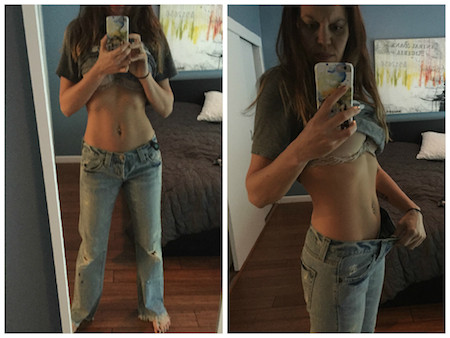How I Set My Goal Weight
HUGE thanks to everyone who attended the live workshop (or watched the replay!)
(I’m loving all your rules, too! Looks like “I do not eat in front of the TV” is a big one!)
Since the workshop, a bunch of you have emailed me asking…
“How do you choose a goal weight?”
It’s a great question (though not with a short answer!)
If you have a lot of weight to lose it can be helpful to set a smaller benchmark initially.
Benji talked a lot about this strategy in his podcast (Listen here)
In the end, Benji lost half himself -- 135 total pounds! But he freely admitted it would have been too overwhelming for him to set a goal of losing 135 lbs, so he made a lot of benchmarks and worked towards those in stride.
Focus on losing an initial 10% of your starting weight…
…but get away from using the scale to track if you can.
I love to tell this story about how I had a goal of “120 lbs” in my head for years, but really, that number did not guarantee I would achieve what I really wanted, which was to fit in a pair of jeans I’d been lugging around as “inspiration” for 10 years.

(You can read more here: Me, My Goal Weight, and a Pair of Jeans.) The story ends happily: I finally fit in the jeans (and they are now too big!) but I never made it to 120 lbs.
Set a measurable goal that isn’t a scale or number -- whether it’s fitting into a pair of “goal pants” like I did, taking measurements, tracking with pictures, or taking Sara’s approach: “I have been chasing a number that I am 30 pounds away from, but truly I just want to run without pain. If that happened at 140 or 160 and not 120 pounds, I wouldn't care. I just want to be comfortable in my body and clothes.”
I’ve also found with myself (and many members) that your body's definition of a goal weight is often different than whatever we pick in our head. It's not uncommon for a member to tell me they "wanted to lose 20 lbs" but lost 40. Or in the case of Benji, he never would have believed he needed to (or could!) lose 100 lbs, let alone 135 lbs.
Sometimes we have no perspective until we start losing, too.
Another story I like to tell is how when I got down to 140 lbs (squarely in the “normal” range for my height) I still wasn’t happy with my appearance. My stomach was still hanging over my pants and my arms and thighs chafed constantly from rubbing.
I then had my body fat measured and discovered I was at the tippy top end of what was considered "healthy" even though I was at a "healthy weight."
With the help of the meal plans, I lost another 12-13 lbs and ONLY then did I finally land in the healthy range.
It was also shocking what a difference 10 lbs made in my appearance and how GOOD I felt.

(You can read more here.)
I always read “throw your scale away” but resisted it with a vengeance. Please learn from my mistake!
Weighing myself daily, and even weekly made me batty. (You can see my log here.)
Eventually I came to appreciate the scale cannot tell me my fat to muscle ratio. The scale can’t tell me if I fit into my favorite jeans or promise I’ll look good naked. And most importantly, the scale has no way of knowing how I feel -- which is strong, fierce, healthy, and yogilicious!
Set a measurable goal with a pair of pants, photos, or measurements! But if you must pick a weight, start with the goal of losing 10% of your starting weight -- you should be able to do that within 2-3 weeks.
Make this the summer of success! Enroll in the meal mentor program. Class starts June 22nd! (for members only)
P.S. Join the Meal Mentor newsletter (it's FREE!) Click here to signup!


